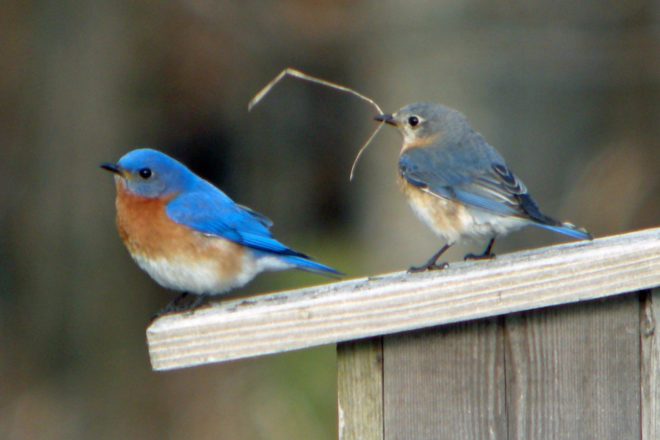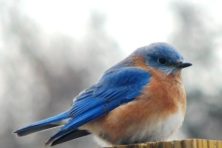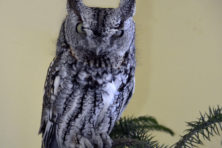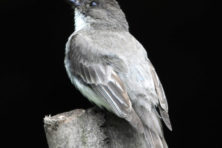Door to Nature: Eastern Bluebirds
- Share
- Tweet
- Pin
- Share

There are many people who have never seen a real bluebird. Other birds are blue – the blue jay and the indigo bunting – but the bluebird is not one that frequents feeders as much as the others. They are not regular seed eaters. Instead, they are birds of the open country, where farms and open fields are found.
I remember that the father of my late husband, Roy, built many bluebird nest boxes and placed them near their farm northwest of Kewaunee. They noticed that some bluebirds would use a slightly rotting wooden fence post and build a nest in the top, which was not very safe or secure.
This is a native species that was threatened by the nonnative European starlings and house sparrows. All of these birds are cavity nesters. During the 1970s, bluebird numbers were declining, so the state’s Department of Natural Resources sent out the word to citizens to help them.
A group of people followed the state’s urging and began the Bluebird Restoration Association of Wisconsin nearly 40 years ago. This nonprofit organization has been very successful in growing the numbers of bluebirds, as well as a couple of other cavity nesters.
Different types of nest boxes were constructed and then monitored once weekly during the nesting season to see how effective each style was. Over the years, they learned which ones were the best and helped people all over the state to develop bluebird trails.
It’s important to learn the preferred habitat for bluebirds and place birdhouses in areas where the birds will use them. Roy and I had a trail of 50 nest boxes almost 20 years ago, but over time, we realized that the habitats were changing: Trees and shrubs were growing more dense, allowing house wrens to move in.
In response, we removed birdhouses that were taken over by wrens, and now my trail is down to 22 boxes. Other species that use the boxes are black-capped chickadees, house wrens and tree swallows. House wrens are not desirable near bluebirds because often the male wren wants the box and stuffs it with twigs until a female arrives.
Sometimes the wren finds a bluebird nest and then pokes holes in the eggs and throws them out of the box. If it’s early enough in the season, we can clean out the box, and perhaps the bluebird will renest. However, the female bluebird may not build again for fear the same thing will happen. That’s why I take a box out of the area when that happens.
Most bluebirds head south in the fall to find food and refuge in the central or southern states. It’s interesting that in autumn, bluebirds’ intestines grow longer so that they can eat berries and fruits to supplement their diet. They typically eat insects, but as colder weather comes, they adapt to having fewer insects around.
Two years ago, when Texas and neighboring states had severe cold and ice for several weeks, many bluebirds perished. If a berry is coated in ice, the bird can’t eat it. We had fewer returning bluebirds, and it was a very poor nesting season in 2021. It was only a little better last summer.
Getting back to bluebird trails, it’s important to place nest boxes far enough apart so bluebirds have enough territory in which to find food. Bluebirds feed on the ground. Tree swallows catch their food in the air. If boxes are placed too close together, you might get only swallows using them.
Some people build a nest box, put it on a pole, then forget about it for the rest of the summer. There are many predators of these blue beauties – including cats, raccoons, opossums, squirrels and snakes – so it is very important to put the box on a pole that these creatures cannot climb and far enough away from tree branches from which these animals could jump to get to the box.
It is vital to check the contents of the box once a week from April to mid- or late August. By doing weekly monitoring, you can help bluebirds that may have a failed nest. Early in the season, you can clean out the nest, and the female may come back to renest.
If a box is not monitored and the nest fails, then it probably won’t be used for the rest of the year. People have asked, “Doesn’t it disturb the bluebird to look in the box?” We let the female know we are nearby by making noise or talking. I quickly open the top to see what’s inside; then, if all is OK, I shut the box and quickly walk away.




